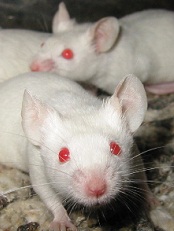
Credit: Aaron Logan
Researchers have identified a cell that appears to be responsible for a particularly aggressive type of leukemia in mice.
The cell is a renin-expressing B-cell progenitor found in the bone marrow.
Renin cells, which are also present in the kidney, have traditionally been associated with the control of blood pressure and fluid balance in the body.
But investigators discovered renin progenitors in the bone marrow of mice with aggressive B-cell leukemia.
And they found evidence to suggest the leukemia originated from a mutation in these renin progenitors—specifically, deletion of RBP-J.
“We would now like to see if this is a relevant model of human disease,” said study author Brian C. Belyea, MD, of the University of Virginia (UVA) School of Medicine in Charlottesville.
“Our long-term goal is to identify cells at increased risk for leukemia in humans and, ultimately, develop strategies to monitor and eliminate these cells.”
Dr Belyea and his colleagues described their initial steps toward this goal in Nature Communications.
In a previous study, the researchers were investigating the effects of RBP-J deletion in mice. And they were surprised to find that, as the mice aged beyond 6 months, they developed signs of an aggressive form of precursor B-lymphoblastic leukemia.
So with the current study, the team wanted to characterize this leukemia. They set out to identify which cells in the bone marrow are capable of producing renin under normal circumstances and whether those cells might be the origin of the leukemia.
The investigators found that renin is expressed by a subset of B-cell progenitors in the mouse bone marrow, and these cells need RBP-J to differentiate.
Deleting RBP-J restrains lymphocyte differentiation, and the mutant cells undergo neoplastic transformation. The mice develop a B-cell leukemia characterized by multi-organ infiltration and resulting in early death.
Experiments showed the leukemia to be particularly hardy. The researchers placed the leukemic cells in a lab dish and found they continued to survive, and even thrive, without any assistance.
“People have been trying to grow leukemia cells in culture, even from patients, and they require other factors to survive, but not these,” said study author Maria Luisa S. Sequeira-Lopez, MD, of UVA.
“These are extremely aggressive in that they have developed a system to grow and survive no matter what,” added author Ariel Gomez, MD, also of UVA. “They have immortalized themselves.”
The researchers now want to determine if these findings will translate to humans. They believe it’s possible, as they were able to identify RBP-J mutations in 10 patients (of 44 screened) with hematologic malignancies. In fact, 5 of the patients had the same frameshift deletion.

